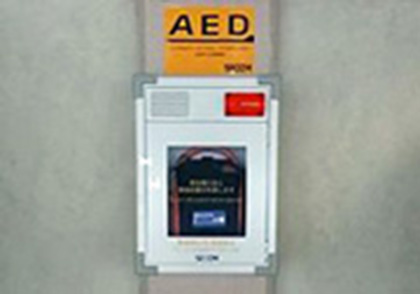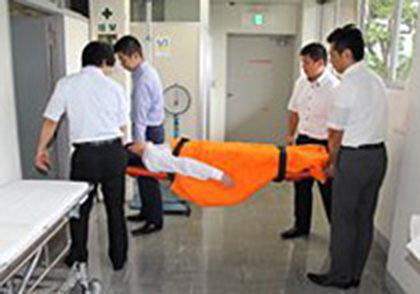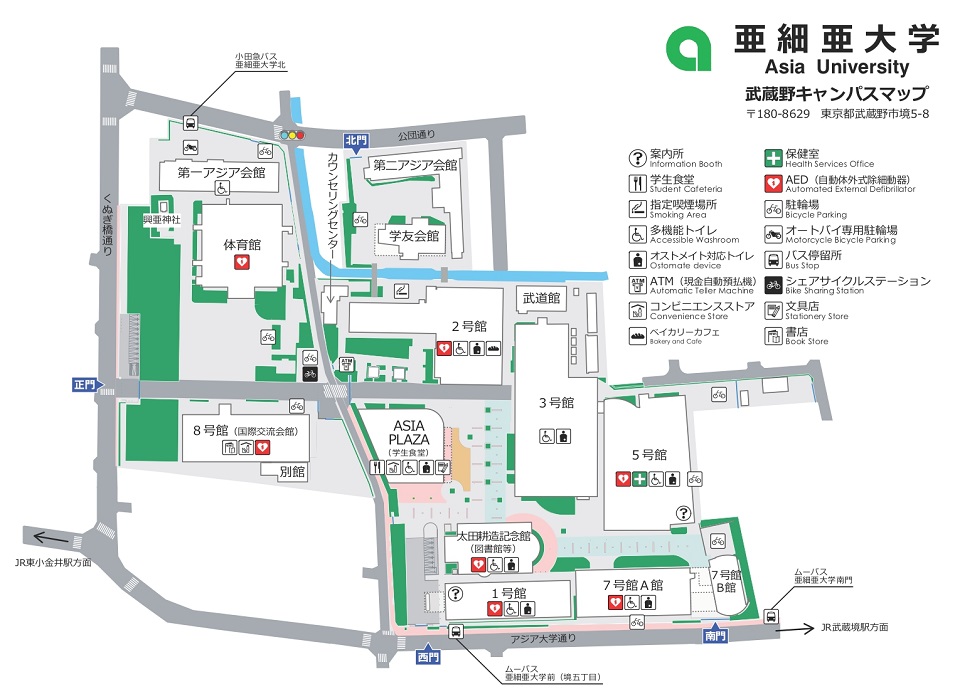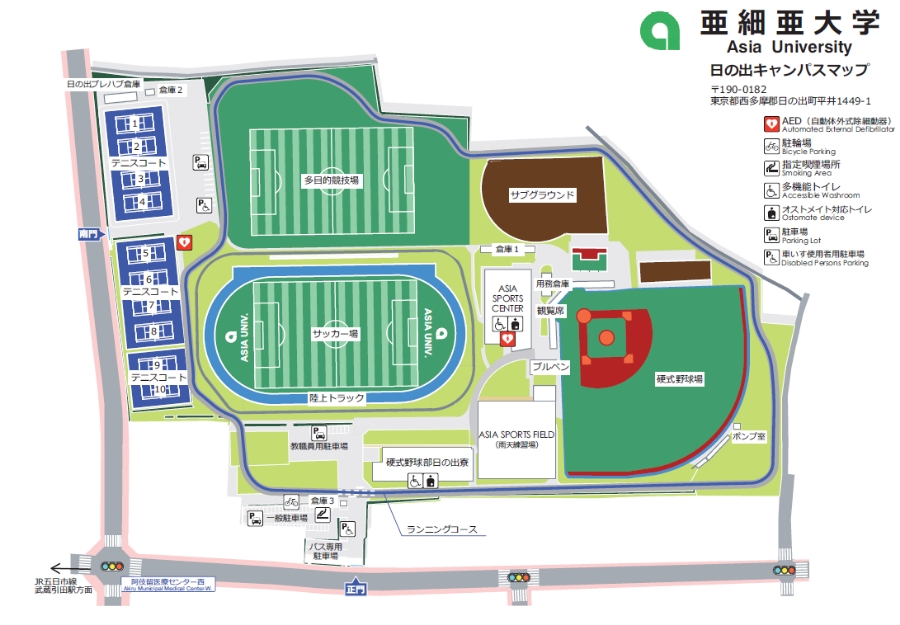- Asia University
- About Asia University
- Efforts of Asia University
- Fire and disaster prevention measures
- Evacuation Site (on campus)
Evacuation Site (on campus)
PAGE SECTIONS
Let's try to deepen our understanding of disasters on a daily basis, pay sufficient attention to safety, and take appropriate actions.
emergency contact
[student]Student Affairs Office Student Center
TEL: 0422-36-3262
E-mail: student@asia-u.ac.jp
[Faculty]
Personnel Division General Affairs Office Affairs Department
TEL: 0422-36-3239
E-mail: jinji@asia-u.ac.jp
Confirmation of safety in the event of a disaster
In the event of a disaster or emergency, the University sends safety confirmation and notification emails from the Asia-University Portal. If you receive an emergency email, please fill in the necessary information and be sure to reply.lifesaving equipment
AED (automated external defibrillator)

An AED (Automated External Defibrillator) is installed on campus.
Most out-of-hospital sudden cardiac deaths are due to "ventricular fibrillation" (a very dangerous arrhythmia in which the muscles in the ventricles spasm and quiver so that the heart cannot beat normally, leading to death within minutes). Thing.
Cardioversion is the only effective treatment to reverse ventricular fibrillation. An electric shock is given to the heart to make it work properly. A device that performs defibrillation easily is called an AED. Anyone can use an AED in an emergency. In order to save an important life from sudden cardiac death, it is important to take emergency measures such as using an AED as soon as possible before the emergency services arrive.
On the Musashino Campus, there is a Security Office on the 1st floor of Building 1, a 1st floor of Building 2, Health Services Office on the 1st floor of Building 5, an entrance on the 1st floor of Building 7 (Building A), a lobby on the 1st floor of Building 8 (International House), and Kozo Ota Memorial Hall They are installed at the entrance on the 1st floor, at the entrance on the 1st floor Gymnasium, at the entrance of the ASIA SPORTS CENTER on the Hinode Campus, and on the north side of tennis court No. 5.
We will hold a seminar on the correct use of AED on campus, so please take it.
Most out-of-hospital sudden cardiac deaths are due to "ventricular fibrillation" (a very dangerous arrhythmia in which the muscles in the ventricles spasm and quiver so that the heart cannot beat normally, leading to death within minutes). Thing.
Cardioversion is the only effective treatment to reverse ventricular fibrillation. An electric shock is given to the heart to make it work properly. A device that performs defibrillation easily is called an AED. Anyone can use an AED in an emergency. In order to save an important life from sudden cardiac death, it is important to take emergency measures such as using an AED as soon as possible before the emergency services arrive.
On the Musashino Campus, there is a Security Office on the 1st floor of Building 1, a 1st floor of Building 2, Health Services Office on the 1st floor of Building 5, an entrance on the 1st floor of Building 7 (Building A), a lobby on the 1st floor of Building 8 (International House), and Kozo Ota Memorial Hall They are installed at the entrance on the 1st floor, at the entrance on the 1st floor Gymnasium, at the entrance of the ASIA SPORTS CENTER on the Hinode Campus, and on the north side of tennis court No. 5.
We will hold a seminar on the correct use of AED on campus, so please take it.
rescue board bench

Rescue board benches for life-saving treatment are placed in 11 locations on campus.
It can usually be used as a bench, but in an emergency, the board on which to sit can be removed and used as a stretcher for rescue activities. (Photo: There is a belt on the back of the board to secure the body, and it is also considered for safety.)
They are installed in Buildings 1, 2, 3, 5, 7, 8 (International House), Kozo Ota Memorial Hall, Gymnasium, Student Association Building, First Asian Hall, and Second Asian Hall.
It can usually be used as a bench, but in an emergency, the board on which to sit can be removed and used as a stretcher for rescue activities. (Photo: There is a belt on the back of the board to secure the body, and it is also considered for safety.)
They are installed in Buildings 1, 2, 3, 5, 7, 8 (International House), Kozo Ota Memorial Hall, Gymnasium, Student Association Building, First Asian Hall, and Second Asian Hall.
Musashino Campus

Hinode Campus

Evacuation Site (on campus)
In order to save lives and reduce damage in the event of a disaster, the university has established Disaster Evacuation Route based on the "Regulations Concerning the Asia Gakuen Fire Fighting Plan". In the event of an emergency such as an earthquake, please evacuate according to the "Disaster Response Manual".About evacuation using "Earthquake Early Warning"
If an earthquake early warning predicts a seismic intensity of 4 or higher
The emergency broadcast system will automatically activate, and the siren will sound throughout the university, followed by an emergency broadcast with the announcement "An earthquake is coming. Please beware of strong tremors."If no big tremors
If there is no big tremor, we will broadcast the response after that. In that case, the evacuation is cancelled.Evacuation behavior
The time it takes for a strong tremor to hit varies depending on the location of the epicenter, but it is estimated that it will take several seconds to several tens of seconds for the tremor to start after the siren or emergency broadcast. Depending on the location, it may not be in time. If there is a siren or emergency broadcast, please ensure your own safety.Evacuation behavior after an earthquake
student
If you are in class, please evacuate to the "Evacuation Site" (the square Gymnasium) according to the instructions of the teacher in charge (see map). Please evacuate to the "Evacuation Site" on your own, paying attention to aftershocks Research Office etc.faculty and staff
Teachers in class should guide students to Evacuation Site according to the evacuation map. The person in charge of disaster prevention should follow the evacuation map and lead the students to Evacuation Site. Other faculty and staff members should evacuate to Evacuation Site. Contractors should call on students to evacuate and evacuate to their own Evacuation Site.Actions at Evacuation Site
student
Please gather according to your academic year and follow the instructions of the person in charge of disaster prevention. Safety will be confirmed by roll call.faculty and staff
Line up by faculty grade and check the safety and number of all students by roll call.(Updated July 20, 2023)